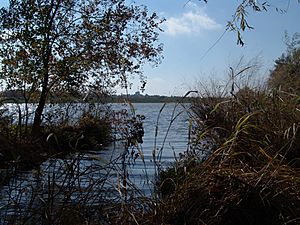Soil Conservation Services Hickory Creek Basin Retarding Pond 16 facts for kids
Little Lake is a special place in Denton, Texas. Its official name is Soil Conservation Services Hickory Creek Basin Retarding Pond #16 (SCS #16). It's part of the Trinity River Basin. This lake was built in 1975 to help stop floods. But over time, it became much more! It's now a home for many animals and a popular spot for people to enjoy nature.
Why Was Little Lake Built?
Long ago, in 1957 and 1962, big floods caused a lot of damage in downtown Denton. Homes and businesses were hurt. To stop this from happening again, a plan was made in 1966. It was called the Hickory Creek flood prevention plan. This plan suggested building seventeen special ponds to control floodwaters.
Only nine of these ponds were ever finished. Two of them are in Denton: Pond #16 (Little Lake) and Pond #17a. Both of these man-made ponds are now inside North Lakes Park. This park covers a large area, about 351 acres (1.4 square kilometers). The main entrance to North Lakes Park is at 2001 W. Windsor. This leads to Pond #17a, which has many things like a recreation center, batting cages, and sports fields.
What Makes Little Lake Special?
Little Lake, or Pond #16, is on the south side of North Lakes Park. You can get to it from North Bonnie Brae Street. Unlike Pond #17a, Little Lake is much less developed. This means it feels more "wild" even though people built it.
Because there aren't many buildings or sports areas, Little Lake has become a home for many different plants and animals. It's also a place where people can enjoy nature in many ways. You might see kayakers, people fishing, or hikers. Many animals also live here, like great blue herons, egrets, and beavers. Dogs and disc golfers also share the space.
Little Lake is a unique mix of a flood control pond, a natural home for wildlife, and a peaceful place for people. It's located near the Dallas–Fort Worth metroplex, which is a very large city area in Texas. This makes Little Lake a great example of how nature and city life can exist together. It shows us how managing our environment can help both nature and people.
Art and Nature at Little Lake
In 2010, Little Lake became part of an art project. An art team from New York called ecoarttech worked with students and teachers from the University of North Texas (UNT). Their project was called "Center for the Wildness in the Everyday."
This project explored how Little Lake, a man-made lake, feels wild and natural at the same time. It made people think about important questions:
- How should we treat our environment?
- How does water help different plants, animals, and cultures?
- How do city plans, environmental care, and local communities work together?
This project helped people see Little Lake not just as a flood pond, but as a living example of how nature and human creations can blend together.


